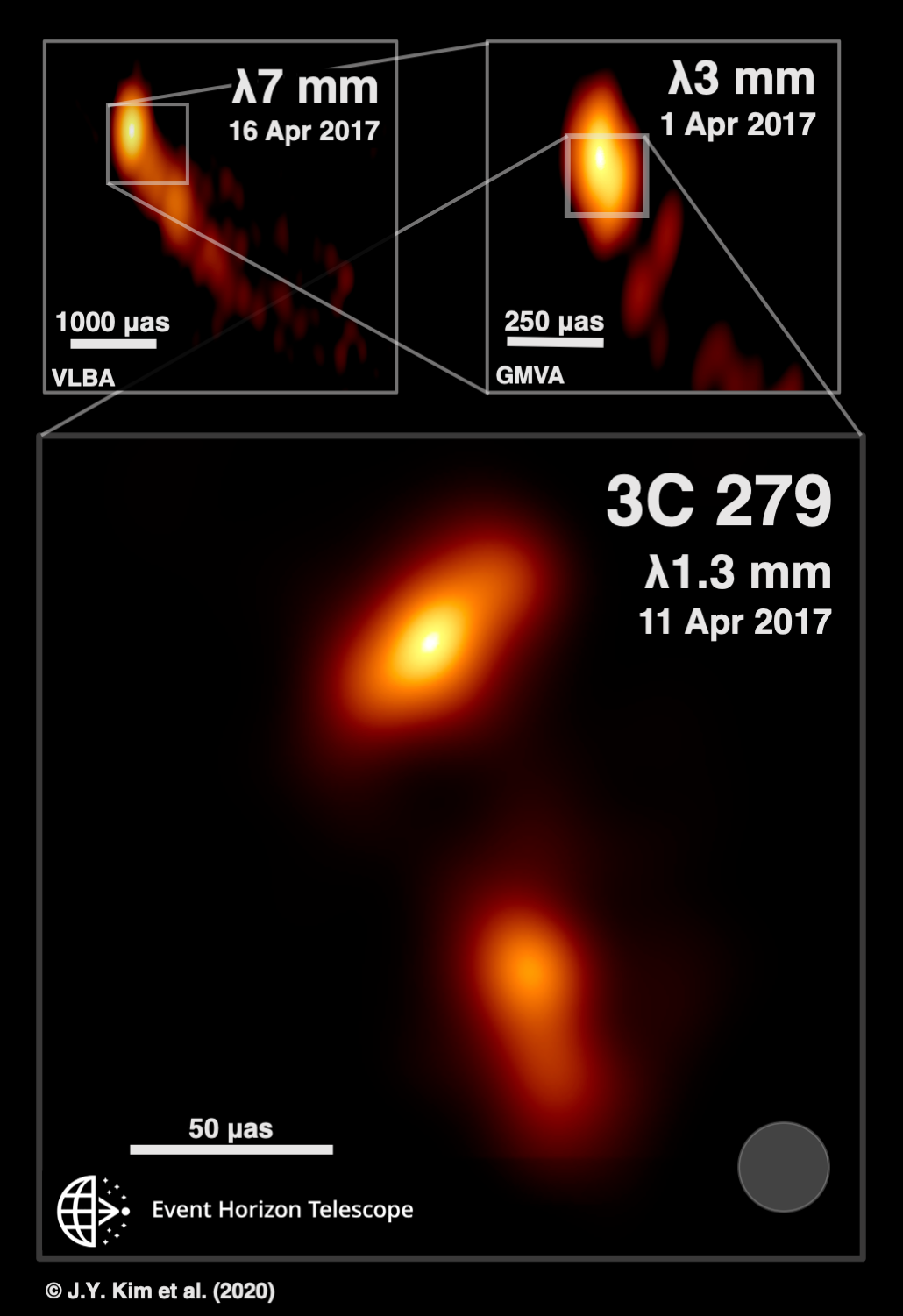The Event Horizon Telescope reveals unexpected structures in quasar 3C279
About a year ago, the Event Horizon Telescope (EHT) collaboration released the first image of a black hole. They have now looked in detail at the high-speed jet of material emerging from a supermassive black hole
The collaboration of the Event Horizon Telescope (EHT), a planetary scale telescope that took the first image of a black hole, continues to extract information from the data collected in its global campaign in April 2017. The objective of the observations in this case it was quasar 3C 279, an active galaxy that contains a supermassive black hole at its core that absorbs matter through a disk and, at the same time, expels part of the gas through two fine jets that emerge from the poles almost to the speed of light. The EHT data, showing the sharpest details ever obtained, allow the jet and disk to be observed in action and revealed unexpected characteristics.
Now, the linked-up telescopes show the sharpest-ever details, down to a resolution finer than a light-year, to better see the jet down to the expected accretion disk and to see the jet and disk in action. The newly analyzed data show the normally straight jet has an unexpected twisted shape at its base and for the first time we see features perpendicular to the jet, which first could be interpreted as the accretion disk from where jets are ejected from the poles. Comparing the images over subsequent days, we see them change in their finest details, so we are perhaps seeing the rotation of the accretion disk with shredding and infall, plus the jet ejection, that previously were seen only in numerical simulations.
Jae-Young Kim, leader of the analysis, is enthusiastic and at the same time puzzled: "We knew that every time you open a new window to the Universe you can find something new. Here, where we expected to find the region where the jet forms by going to the sharpest image possible, we find a kind of perpendicular structure. This is like finding a very different shape by opening the smallest Matryoshka doll." Furthermore, the fact that the images change so fast has also surprised astronomers. "Relativistic jets show apparent superluminal motions, as an optical illusion, but this, perpendicular to the expectation, is new and requires careful analysis", adds Jae-Young-Kim.
"During the last decades VLBI observations of quasar 3C279 have allowed us to establish a physical model capable of explaining how these supermassive black holes can become the most energetic objects in the universe, but a single EHT image has been enough to rethink many of our hypotheses previous, and in particular how the jets are generated from the increase of matter around the central black hole ”, says José Luis Gómez, researcher at the Institute of Astrophysics of Andalusia (IAA-CSIC) and member of the research team.
The interpretation of the observations is challenging. Transversal apparent motions of about 20 times the speed of light are difficult to reconcile with the early understanding of the source, this suggests traveling shocks or instabilities in a bent, possibly rotating jet, which also emits at high energies, such gamma-rays.

The telescopes contributing to this result were ALMA, APEX, the IRAM 30-meter telescope, the James Clerk Maxwell Telescope, the Large Millimeter Telescope, the Submillimeter Array, the Submillimeter Telescope, and the South Pole Telescope.
The telescopes work together using a technique called very long baseline interferometry (VLBI). This synchronises facilities around the world and exploits the rotation of our planet to form one huge, Earth-size telescope. VLBI allows the EHT to achieve a resolution of 20 micro-arcseconds — equivalent to identifying an orange on Earth as seen by an astronaut from the Moon. The data analysis to transform raw data to an image required specific computers (or correlators), hosted by the MPIfR in Bonn and the MIT Haystack Observatory.
Anton Zensus, Director at the MPIfR and Chair of the EHT Collaboration Board, stresses the achievement as a global effort: "Last year we could present the first image of the shadow of a black hole. Now we see unexpected changes in the shape of the jet in 3C 279, and we are not done yet. We are working on the analysis of data from the centre of our Galaxy in Sgr A*, and on other active galaxies such as Centaurus A, OJ 287, and NGC 1052. As we told last year: this is just the beginning."
The March/April 2020 observing campaign of the EHT was cancelled due to the CoViD-19 global outbreak. The EHT Collaboration is now determined on the next steps to follow both in new observations and in the analysis of existing data. Michael Hecht, astronomer from the MIT/Haystack Observatory and EHT Deputy Project Director, concludes: "We will now devote our full concentration to completion of scientific publications from the 2017 data and dive into the analysis of data obtained with the enhanced EHT array in 2018. We are looking forward to observations with the EHT array expanded to eleven observatories in the spring of 2021".
J.Y. Kim, T.P. Krichbaum, A.E. Broderick, et al.: Event Horizon Telescope imaging of the archetypal blazar 3C 279 at an extreme 20 microarcsecond resolution, in: Astronomy & Astrophysics, April 2020 https://doi.org/10.1051/0004-6361/202037493
Instituto de Astrofísica de Andalucía (IAA-CSIC)
Unidad de Divulgación y Comunicación
Silbia López de Lacalle - sll[arroba]iaa.es - 958230676
https://www.iaa.csic.es
https://divulgacion.iaa.csic.es

